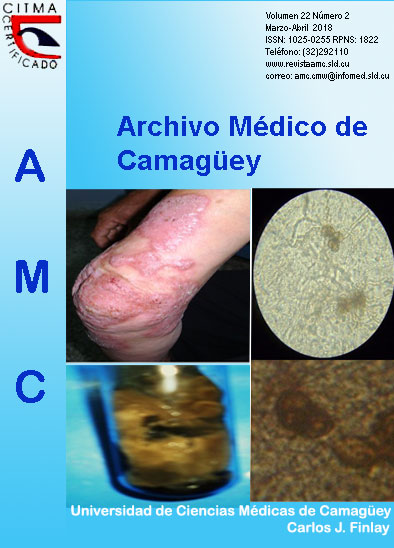New contributions from the microbiology in order to understand the autism
Keywords:
autismo, microbiota intestinal, disbiosis intestinal, disbacteriosis, intestino permeable.Abstract
Background: in order to understand the origin of the dysfunctions of the autistic spectrum, an etiological and multifactorial approach is needed. New evidence indicates that imbalances in the composition of the intestinal microbiota can influence unfavorably in the evolutionary course of this illness due to very established physiopathological mechanisms. The article is the result of an extensive literature revision for the design of future research.
Objective: to analyze the existing theoretical information about the role of the intestinal microbiota in the evolution of patients with dysfunctions in autistic spectrum.
Methods: a thematic revision through a bibliographic search carried out from 2000 to 2016 was conducted, without any language barrier. Data bases SciELO, Hinari, BVS, Lilacs, Medline and PubMed were consulted. Thirty documents were selected, including national and international scientific publications. The localized terms in DeSC were: autism, microbiota, intestinal microbiota, disbiosis, disbacteriosis, permeable instestine.
Development: the role of the human microbiota has been redefined and it is recognized now as another organ in the human body. When there is a problem with natural balance, such as Candida - they can grow quickly and aggressively, causing damages in the intestinal permeability of the mucous one and allowing the macromolecules step and metabolic residuals to the sanguine torrent, generating biochemical changes that are reflected in worsening of the autism’s behavior.
Conclusions: in the last years numerous articles that have revolutionized the focus of many pathologies have been published, involving the intestinal disbiosis with the severity of the autistic symptoms. Therefore, a promising investigation field was found, where people should work to identify the involved microorganisms, to define their roles in the evolution of these dysfunctions and to study the therapeutic possibilities to alleviate their symptoms.
DeCS:AUTISTIC DISORDER; GASTROINTESTINAL MICROBIOME; DYSBIOSIS; GASTROINTESTINAL MICROBIOME; REVIEW LITERATURE AS TOPIC.
Downloads
References
1.Brent L. Intestinal Gene Expression and Dysbiosis in Autism. PLoS ONE [Internet]. 2011 [citado 27 Feb 2015];6(9):[aprox. 9 p.]. Disponible en: http:// www.plosone.org
2. Fitzgerald K, Hyman M. Trastornos del espectro autista. Glob Adv Health Med [Internet]. 2012 [citado 28 Abr 2016];1(4):[aprox. 7 p.]. Disponible en: http://www.gahmj.com/toc/gahmj/1/4
3.Audisio A, Laguzzi J. Mejora de los síntomas del autismo y evaluación alimentaria nutricional luego de la realización de una dieta libre de gluten y caseína en un grupo de niños con autismo que acuden a una fundación. Nutr clín diet hosp [Internet]. 2013 [citado 20 Ene 2015];33(3):[aprox. 8 p.]. Disponible en: http://dx.doi:10.12873/333glutencasein
4.Hernández O. ¿Síndrome de Asperger o buena evolución de un autismo infantil? Med Electr. 2015;19(4):12-21.
5.Oviedo N. Aspectos genéticos y neuroendocrinos en el trastorno del espectro autista. Bol Med Hosp Infant Mex [Internet]. 2015 [citado 28 Abr 2016];72(1):[aprox. 9 p.]. Disponible en: http://dx.doi.org/10.1016/j.bmhimx.2015.01.010
6.Alparo Herrera I. Manifestaciones gastrointestinales en niños con espectro autista. Rev bol Ped [Internet]. 2013 [citado 27 Feb 2015];52(3):[aprox. 12]. Disponible en: http://www.scielo.org.bo/scielo.php?pid=S1024-06752013000300007&script=sci_arttext&tlng=es
7.Whilby M, Ravelo V, Ramos L. Autismo Infantil: Trastornos digestivos asociados. Rev Hosp Psiq de La Habana [Internet]. 2011 [citado 16 Oct 2016];8(3):[aprox. 9 p.]. Disponible en:http://wwwrevistahph.sld.cu/hph3-2011/hph01311.htl
8.Castro Ruz F. Discurso del 4 de enero de 2002 en la inauguración de la Escuela Especial para niños autistas Dora Alonso. Granma. 5 Ene 2002;Sect. política (col. 3).
9.Benach JL, Li E, McGovern M. A Microbial Association with Autism. mBio [Internet]. 2012 [cited 2015 May 28];3(1):[about 9 p.]. Available from: http://dx.doi:10.1128/mBio.00019-12
10.Adams J, Johansen L, Powell L. Gastrointestinal flora and gastrointestinal status in children with autism–comparisons to typical children and correlation with autism severity. BMC Gastroenterology [Internet]. 2011 [cited 2015 Feb 27];11(22):[about 5 p.]. Available from: http://www.biomedcentral.com/1471-230X/11/22
11.Díaz-Zepeda C, Escobar J. Blancos farmacológicos en el eje intestino-cerebro. Rev Farmacol Chile. 2015;8(1):7-18.
12.Borre Y, Moloney R, Clarke G, Dinan T, Cryan J. Microbial Endocrinology: The Microbiota-Gut-Brain Axis in Health and Disease. Adv Exp Med Biol [Internet]. 2014 [cited 2015 Feb 27];17(4):[about 6 p.]. Available from: http://dx.doi.10.1007/978-1-4939-0897-4_17
13.Theoharis C. On the Gut Microbiome-Brain Axis and altruism. Clin Therap [Internet]. 2015 [cited 2016 Feb 11];37(5):[about 12 p.]. Available from: http://dx.doi.org/10.1016/j.clinthera.2015.04.003
14.Gotteland M. El papel de la microbiota intestinal en el desarrollo de la obesidad y de la diabetes de tipo-2. Rev chil endocrinol Diabetes [Internet]. 2013 [citado 27 Feb 2015];6(4):[aprox. 7 p.]. Disponible en: http://revistasoched.cl/4_2013/index-4-2013.html
15.Peris-Bondia F. Fraccionando la microbiota gastrointestinal humana [tesis de Doctorado]. España: Universidad de Valencia; 2012 [citado 27 Feb 2015]. Disponible en: http://roderic.uv.es/handle/10550/24147
16.Peled J. Role of gut flora after bone marrow transplantation. Nature Microbiology [Internet]. 2016[cited 2016 May 17];1:[about 5 p.]. Available from: http://dx.doi.org/10.1038/nmicrobiol.2016.36
17.Zhi L. Abrupt suspension of probiotics administration may increase host pathogen susceptibility by inducing gut dysbiosis. Sci Rep [Internet]. 2016 [cited 2016 May 17];6:[about 23214 p.]. Available from: http://dx.doi.org/10.1038%2Fsrep23214
18.Rahul R, Vivek A, Radha K. Gut Microbiota: Its Role in Hepatic Encephalopathy. J Clin Exp Hepatol [Internet]. 2015 [cited 2016 May 17];5(1):[about 7 p.]. Available from: http://dx.10.1016/j.jceh.2014.12.003
19.Koboziev I, Reinoso C. Role of the enteric microbiota in intestinal homeostasis and inflammation. Free Radic Biol Med [Internet]. 2014 [cited 2015 Feb 27];68:[about 10 p.]. Available from: http://www.ncbi.nlm.nih.gov/pmc/articles/PMC3943931/
20.Cintia S, Dan B, Stern E. Altered Mucosal Microbiome Diversity and D.isease Severity in Sjögren Syndrome. Sci Rep [Internet]. 2016[cited 2016 May 11];6:[about 23561 p.]. Available from: http://dx.doi.org/10.1038%2Fsrep23561
21.Parracho H, Bingham M, Gibson G, McCartney A. Differences between the gut microflora of children with autistic spectrum disorders and that of healthy children. J Med Microbiol [Internet]. 2005 [cited 2015 Feb 27];54:[about 5 p.]. Available from: http://dx.doi 10.1099/jmm.0.46101-0
22.Moreno X, Santamaría G, Sánchez R, Torre B de la. Microbiota gastrointestinal aeróbica en niños con trastorno del espectro autista. Estudio preliminar. Gen [Internet]. 2015 [citado 4 May 2016];69(2):[about 6 p.]. Disponible en: http://www.scielo.org.ve/scieloOrg/php/articleXML.php?pid=S0016-35032015000200004&lang=es
23.Francino MP. Antibiotics and the Human Gut Microbiome: Dysbioses and accumulation of resistances. Front Microbiol [Internet]. 2015 [cited 2016 May 4];6:[about 1543 p.]. Available from: http://dx.doi.org/10.3389%2Ffmicb.2015.01543
24.Shaw W, Kassen E, Chaves E. Assessment of antifungal drug therapy in autism by measurement of suspected microbial metabolites in urine with gas chromatography-mass spectrometry. Clin Pract Alt Med. 2000;1(1):15-26.
25. Castillo-Álvarez F, Marzo ME. Papel de la microbiota intestinal en el desarrollo de la esclerosis múltiple. Neurología [Internet]. 2015 [citado 28 Abr 2016];7(5):[aprox. 12 p.]. Disponible en: http://dx.doi:10.1016/j.nrl.2015.07.005
26.Saavedra V. Candidiasis Intestinal I. Med Integr [Internet]. Ene 2007[citado 2015 Feb 27];11:[aprox. 16 p.]. Disponible en: http:/www.medicinaintegral.es/.
27.Aguilar YD. Etiología, susceptibilidad in vitro y factores predisponentes asociados a la candidiasis vulvovaginal. La Habana [tesis]. La Habana: Instituto de Medicina Tropical Pedro Kourí (IPK); 2012.
28.Tapia C, Alburquenque C. Interacción Candida albicans–Hospedero: un proceso complejo en el que la inmunidad innata juega un papel importante. Bol Micol. 2013;28(2):37-47.
29.Burrus CJ. A biochemical rationale for the interaction between gastrointestinal yeast and autism [Internet]. 2012 [cited 2015 Feb 27];79(6):[about 2 p.]. Available from: http://dx.doi.10.1016/j.mehy.2012.08.029. Epub 2012 Sep 26
30.Kantarcioglu AS. Microbiota–Gut–Brain Axis: Yeast Species Isolated from Stool Samples of Children with Suspected or Diagnosed Autism Spectrum Disorders and In Vitro Susceptibility against Nystatin and Fluconazole. Mycopathologia [Internet]. 2016 [cited 2016 Ene 27];181:[about 7 p.]. Available from: http://dx.doi.10.1007/s11046-015-9949-3
Published
How to Cite
Issue
Section
License
Copyright: Camagüey Medical Archive Magazine, offers immediately after being indexed in the SciELO Project; Open access to the full text of the articles under the principle of making available and free the research to promote the exchange of global knowledge and contribute to a greater extension, publication, evaluation and extensive use of the articles that can be used without purpose As long as reference is made to the primary source.
Conflicts of interest: authors must declare in a mandatory manner the presence or not of conflicts of interest in relation to the investigation presented.
(Download Statement of potential conflicts of interest)
The Revista Archivo Médico de Camagüey is under a License Creative Commons Attribution-Noncommercial-No Derivative Works 4.0 International (CC BY 4.0).
This license allows others to distribute, to mix, to adjust and to build from its work, even for commercial purposes, as long as it is recognized the authorship of the original creation. This is the most helpful license offered. Recommended for maximum dissemination and use of licensed materials. The full license can be found at: https://creativecommons.org/licenses/













 22 julio 2025
22 julio 2025